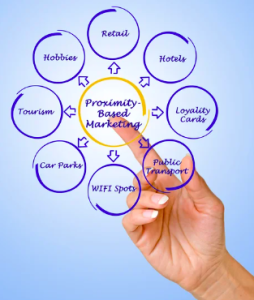Proximity Marketing
Definition
Proximity marketing is a location-based marketing strategy that delivers targeted advertising messages to consumers based on their physical proximity to a business or product.
Description
It relies on wireless technologies such as Bluetooth, Wi-Fi, GPS, and NFC (Near Field Communication) to send messages to mobile devices such as smartphones and tablets.
Source:www.google.com
It can take many forms, including push notifications, in-app messaging, SMS (text message) marketing, and beacon-based advertising. Push notifications are messages on a mobile device when a user is near a particular location or product. In-app messaging involves displaying targeted messages when a user is near a specific area. SMS marketing involves sending text messages to users near a particular location. Beacon-based advertising involves using small Bluetooth devices called beacons to send targeted messages to mobile devices when they are in range.
It can be used in retail stores, shopping malls, airports, museums, and stadiums to deliver targeted advertising messages, promotions, coupons, and other incentives to drive foot traffic, increase sales, and improve the overall customer experience.
This type of marketing increases customer engagement, improved customer targeting, and better ROI (return on investment) for marketing campaigns. It also allows businesses to collect valuable data on customer behaviour and preferences, which can be used to refine marketing strategies and improve business operations.
Importance of Proximity Marketing
It is becoming increasingly important in today’s digital world, as it provides businesses with an effective way to reach customers in a highly targeted and personalised manner. Here are some of the critical benefits and importance of proximity marketing:
- Increased Customer Engagement: By delivering relevant and personalised messages to customers based on location, it can help businesses engage customers and capture their attention. This can increase brand awareness, customer loyalty, and, ultimately, higher sales.
- Improved Customer Targeting: It allows businesses to target customers with highly relevant messages based on location, interests, and behaviour. This can help enhance marketing campaigns’ effectiveness and increase ROI (return on investment).
- Cost-Effective: It is often more cost effective than traditional forms of advertising, such as TV or print ads. It allows businesses to reach customers in real time, at the exact moment when they are most likely to make a purchase.
- Valuable Data Collection: It provides businesses with valuable data on customer behaviour and preferences, such as how often they visit a store, what products they are interested in, and how long they stay in a particular location. This data can be used to refine marketing strategies and improve business operations.
- Improved Customer Experience: It can help to improve the overall customer experience by providing customers with relevant and personalised messages and offers. This can help to build customer loyalty and drive repeat business.
How to begin with Proximity Marketing?
To begin with proximity marketing, businesses can follow these steps:
- Define your target audience: Identify the target audience you want to reach with your campaign. This can include demographics, location, interests, and behaviours.
- Choose the right technology: Select the right technology for your campaigns, such as beacons, NFC (Near Field Communication), or GPS (Global Positioning System). Each technology has benefits and limitations, so choose the most suitable for your business and target audience.
- Develop a strategy: Develop a strategy for your marketing campaign, including the type of messages you want to deliver, the frequency of messages, and the channels you want to use (e.g., mobile app, text message, email).
- Create engaging content: Create engaging content relevant and personalised to your target audience. This can include offers, promotions, and discounts tailored to their interests and location.
- Implement and test: Implement your marketing campaign to ensure it is working as intended. Monitor the performance of your campaign and make adjustments as needed.
- Analyse and refine: Analyse the data collected from your proximity marketing campaign and refine your strategy based on the results. This can improve the effectiveness of your campaign and drive better results over time.
Types of Proximity Marketing
Businesses can use several types of proximity marketing to engage with customers in a targeted and personalised way. These include:
- Beacon-based marketing: This involves using Bluetooth Low Energy (BLE) beacons to deliver targeted messages to customers close to the beacon. These messages can include promotional offers, discounts, and other personalised content.
- NFC-based marketing involves using Near Field Communication (NFC) technology to enable customers to interact with physical objects, such as posters or packaging, using their mobile devices. This can deliver product information, promotions, and other relevant content.
- GPS-based marketing involves using Global Positioning System (GPS) technology to deliver targeted messages to customers based on their location. This can promote nearby businesses, events, or other relevant content.
- Wi-Fi-based marketing: This involves using Wi-Fi networks to deliver targeted messages to customers within a specific Wi-Fi access point. This can promote products, services, or other relevant content.
- QR code-based marketing involves using Quick Response (QR) codes to enable customers to scan a code and receive targeted messages or promotions. This can be used to drive traffic to a specific location or to promote a product or service.
Future Scope of Proximity Marketing
The future of proximity marketing is promising as technological advancements expand their potential. Here are some potential future developments:
- Increased personalisation: As it becomes more advanced, it will enable businesses to deliver even more personalised and relevant messages to customers based on their behaviours, preferences, and real-time context.
- Integration with other technologies: It will likely be integrated with other technologies, such as artificial intelligence, augmented reality, and virtual reality, to create more immersive and engaging customer experiences.
- Expansion of use cases: It will be used in new and creative ways, such as in-store navigation, product recommendations, and gamification.
- Increased use in public spaces: As cities become more intelligent and connected, it will be used more frequently in public spaces, such as museums, parks, and transportation hubs.
- Integration with the Internet of Things (IoT): Proximity marketing will be integrated with IoT devices, such as intelligent home assistants and connected cars, to deliver targeted messages and promotions to customers in new and innovative ways.
Example
Starbucks, the coffee chain, uses a mobile app to connect with customers and offer personalised promotions and rewards based on their location and purchase history. The app uses geofencing technology to detect when a customer is near a Starbucks location and sends notifications about special offers or new menu items. Starbucks uses beacon technology in some stores to send targeted messages and promotions to customers as they browse the store.
FAQ
What is proximity marketing?
It is a form of marketing that uses location-based technologies, such as Bluetooth, Wi-Fi, and GPS, to communicate with customers when they are near a business or specific location.
What are the benefits of proximity marketing?
Engagement, build brand awareness, drive foot traffic to physical locations, and deliver personalised and relevant customer messages are the benefits for this marketing.
What are the types of proximity marketing?
The kinds of proximity marketing include Bluetooth beacons, geofencing, and NFC (near-field communication) technology.
How does proximity marketing work?
Proximity marketing uses a mobile device’s location-based services to detect when a customer is close to a business or location. Once the customer is detected, targeted messages, promotions, or other forms of communication can be sent to their device.
Is proximity marketing intrusive?
Proximity marketing can be seen as intrusive if customers feel their privacy is invaded. However, if done correctly, proximity marketing can be a valuable tool for delivering personalised and relevant messages to customers when they are most likely to engage with a business.
What are some examples of brands using proximity marketing?
Examples of proximity marketing brands include Starbucks, Macy’s, and Walgreens, all of which use mobile apps and location-based technologies to connect with customers and deliver personalised messages and promotions.
What are some best practices for proximity marketing?
Best practices for proximity marketing include getting permission from customers before sending them messages, personalising messages based on customer behaviour and preferences, and delivering relevant and timely messages to maximise engagement.






We would love to have your opinion.